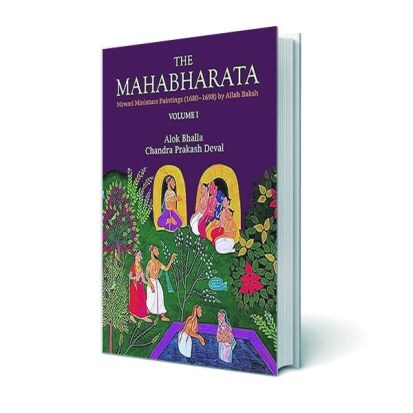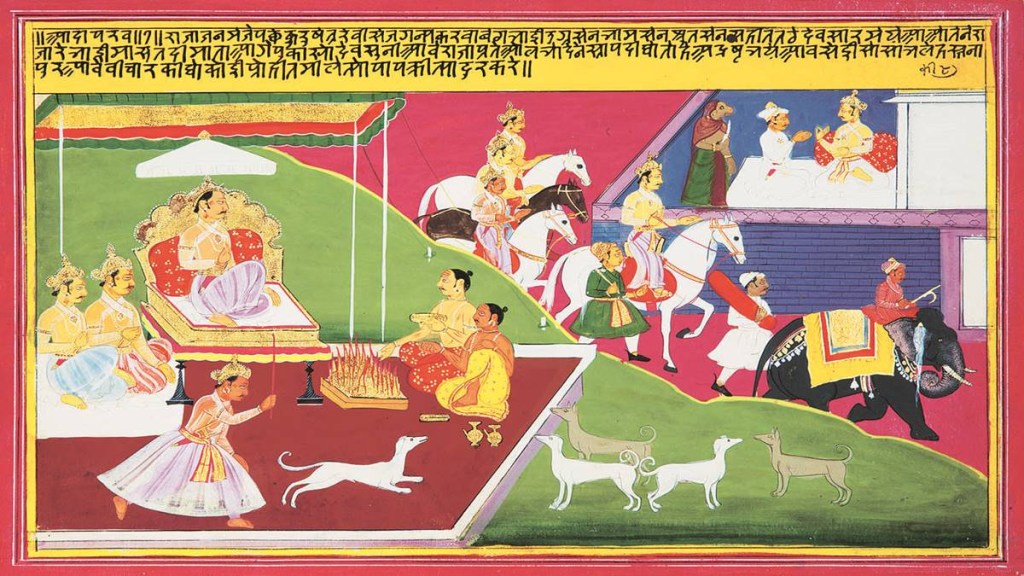The Mahabharata: Mewari Miniature Paintings (1680-1698) by Allah Baksh: Volumes I-IV
Alok Bhalla & Chandra Prakash Deval
Niyogi Books
Pp 1,994, Rs 12,000
In the beginning of the Mahabharata is an early sloka describing a snake sacrifice by Kuru king Janamejaya to seek revenge for the death of his father, Parikshit, in a snake bite. As the sacrifice is in progress, a dog named Deva Suni enters the ritual area angering the king’s brothers who were protecting the sacred fire. Beaten up, Deva Suni runs to his divine mother, Sarama, complaining he was unfairly punished. ‘I didn’t commit a sin nor pollute the sacrificial butter,’ the dog speaks. Sarama soon puts a curse on Janamejaya that evil will befall him.
The text seeking ahimsa and empathy for life in Mahabharata’s Adi Parva, the Book of the Beginning, and the first of the 18 books of the great epic written by the sage Vyasa, had been skillfully interpreted in a miniature painting when scholars Alok Bhalla and Chandra Prakash Deval discovered it in a set of aluminium trunks containing 5,000 such miniature works at the City Palace Government Museum in Udaipur, Rajasthan, eight years ago.
“It is a monumental work by a single school of miniature painting. A complete work of paintings of the Mahabharata has never been done before,” says Deval, a prominent Rajasthani poet, author and translator. He found the name of the artist on the colophon of a verse. It was written Allah Baksh. “Allah Baksh was a Mewari painter,” Deval explains. “He was commissioned by the then Maharana Jai Singh of Udaipur to paint the entire Mahabharata in 1680. The work was completed 18 years later.”

It was the summer of 2015 when Bhalla and Deval chanced upon the treasure of Baksh’s 17th-century miniature paintings. In the next eight years, the two scholars painstakingly poured over photo prints of 80% of the 5,000 paintings to write a four-volume book. Published by Niyogi Books, The Mahabharata: Mewari Miniature Paintings (1680-1698) by Allah Baksh: Volumes 1-IV, was released recently. Both the authors were present. There were also historians, writers, artists and students celebrating a seminal book.

Jai Singh of Udaipur in 1680
Each of the four-volume book contains a note on the text in Mewari language appearing on the miniature paintings to describe the slokas of the epic, a general introduction to the paintings, an introduction to each of the Parvas or books of the Mahabharata, and mainly each book of the epic as visually retold by Allah Baksh. “He painted the epic chapter by chapter, verse by verse,” says Bhalla, a prolific author himself whose books include Stories about the Partition of India (four volumes), Partition Dialogues and The Life and Times of Saadat Hasan Manto.
Rajasthan’s famous tradition of miniature paintings existing in various schools of styles in Mewar, Marwar, Devgarh, Bundi and Baghera resonate in the techniques of Allah Baksh, who heavily relies on the flora and fauna of the Aravallis, rivers, flowers, fruit-bearing trees, birds and the diminutive nature of the people in the Mewar region. He came from a family of Mewari miniature painters, including his father and grandfather who were members of the durbar of Maharana Pratap Singh. Allah Baksh had help in his massive work from another Mewari legend, Bhat Krishnadas, who translated the Mahabharata into Mewari from the original Sanskrit more than three-and-half centuries ago. The paintings contain references to royal patronage and even the price of each work, a high `1.5 back then.
Bhalla and Deval’s four-volume book has 2,000 of Allah Baksh’s 5,000 paintings of the Mahabharata. Niyogi Books published a fifth volume by the authors—The Gita: Mewari Miniature Painting (1680-1698) by Allah Baksh— with 500 paintings from Bhagavad Gita, four years ago. There is a visual distinction between the paintings of Bhagavad Gita, which are vertical, and the rest of the Mahabharata that are horizontal. “All the 5,000 paintings had been itemised, catalogued and properly preserved in the City Palace Government Museum. But nobody had seen them before. They were carefully wrapped in muslin cloth and kept in the trunks,” says Bhalla. “Allah Baksh’s paintings are vibrant in colour and energetic in design with an endless variety of life. Their biggest message is ahimsa. His ethical quest is for non-violence.”
“There are fewer illustrated versions of the Mahabharata in Indian art unlike the Ramayana because of the enormous scale of the enterprise,” says art historian Naman P Ahuja. “A complete illustrated Mahabharata series is rare to find. Allah Baksh’s paintings were a landmark achievement. The work locates the mythic imagination of history in Mewar in the 17th century. It is a tradition that holds back on Mughalising art. It resists and incorporates,” he adds. Sahibdin, another Mewari artist, retold the Ramayana in miniature paintings with Mewari text a generation before Allah Baksh. “The first enormous enterprise of translations was undertaken by Akbar in the 16th century with his Maktab Khana,” says Ahuja. Under Maktab Khana Indian texts, including the Mahabharata and the Ramayana, were translated from Sanskrit into Persian.
In Allah Baksh’s Mahabharata, the brief narrations in text he provides at the top of each miniature painting, is in Mewari, from the translation carried out before him by Bhat Krishnadas. At the end of the work, the artist persists with the portrayal of a dog as he began in the first sloka. In Mahaprasthana Parva, the Book of Great Departure, a dog is seen by the side of Yudhishthira, who is about to enter the heaven. Yudhishthira demands that the dog be allowed to enter before him.
Faizal Khan is a freelancer








